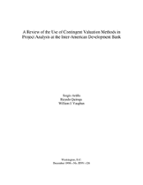A Review of the Use of Contingent Valuation Methods in Project Analysis at the Inter-American Development Bank
Date issued
Dec 1998
Subject
Investment Project;
Sanitation Service;
Water Quality;
Water Management;
Environmental Policy
Category
Working Papers
This paper (ENV-126) was originally presented at a National Science Foundation Workshop on Alternatives to Traditional Contingent Valuation Methods in Environmental Valuation, held at Vanderbilt University, Nashville Tennessee, on October 15-16, 1998. This paper reviews the past ten years of the Inter-American Development Bank's experience with stated preference methods, concentrating on their use in the cost-benefit analysis of projects supplying sewer service and improving ambient water quality in Latin America and the Caribbean. It reports the range of willingness to pay estimates involved, and comments on some of the most important economic analysis issues that appear to have arisen. Among these are the effect that alternative econometric specifications of the choice model can have on our estimates of average (or median) household willingness to pay derived from referendum CV surveys, the need to match what any investment project purports to achieve in a CV survey to what it will actually achieve in practice, and the role of sensitivity analysis in portraying the distribution of expected gross and net project benefits.



